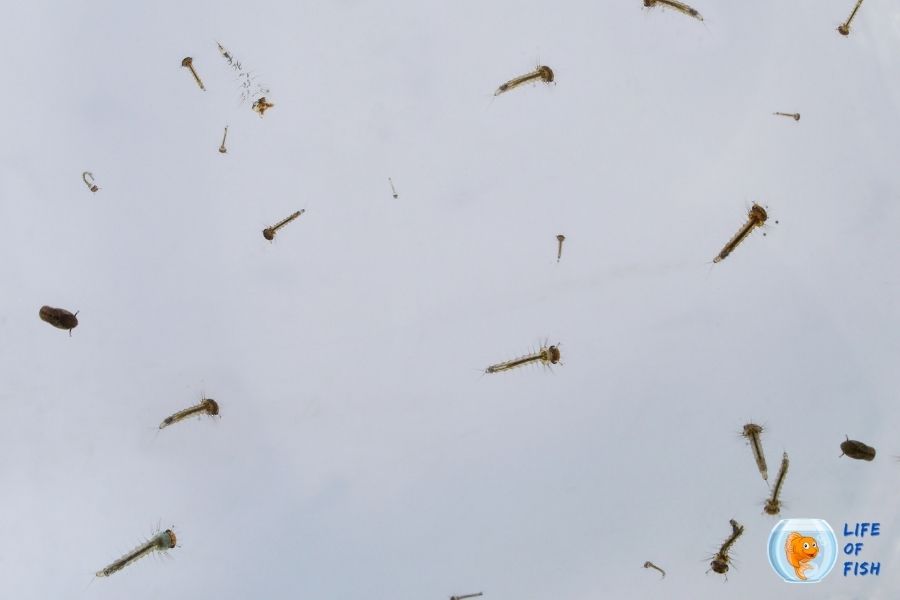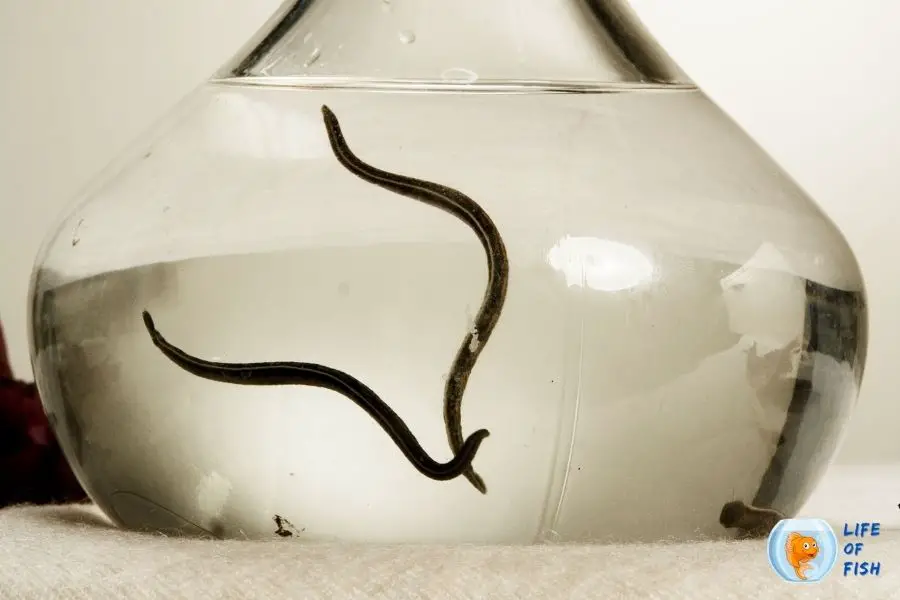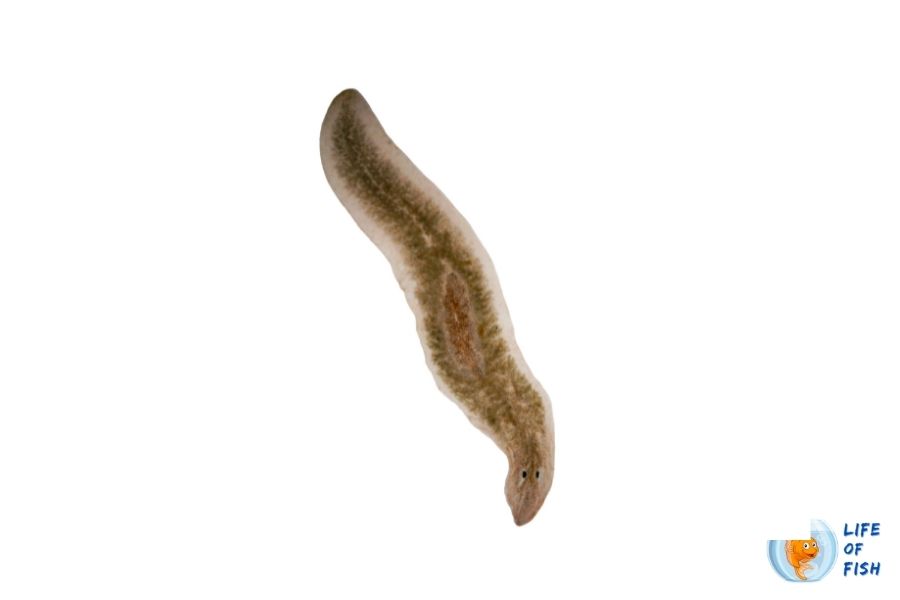Seeing a worm in your aquarium can be the most disgusting thing you’ll see for the day. What if they are blackworms? Things get a little more awkward because black worms highlight, among other things.
So, let’s learn how to get rid of black worms in this article.

What are blackworms?
Jump To
We commonly say blackworms for several types of worms, that grow in an aquarium. Generally, these worms are black in color, but each worm is different in appearance.
Some of them swim freely in the tank, while some of them live on fish as parasites. Those who live freely are an excellent source of food for your fish but may disturb the aesthetic appearance of your tank.
You should be careful with parasitic black worms and get rid of them immediately.
Are blackworms harmful/Useful?
Some black worms are useful, while some are harmful to your fish. Those who live freely in the aquarium are harmless to your fish.
They are actually an asset for you because fish eats them. Some examples of harmless black worms are,
- Drain fly larva
- Blood worms
- Mosquito Larva
- Leeches
- Lumbriculus variegatus
Some black worms live as parasites in fish’s bodies. As you know, all parasite types do harm your fish one way or another.
Further, some parasites are deadly for your fish. So, identifying these black worms before they harm your fish is essential. Some harmful black worms are,
- Planaria
- Anchor Worms
- Camallanus worms
How to detect blackworms in an aquarium
Detecting black worms isn’t hard because all of them have one common color. They are all black, and it is hard not to detect them.
Identifying black worms is the hardest part. You might misidentify harmful black worms with harmless black worms and not care about them until your fish dies.
That is why you should observe these worms carefully.
One blackworm you will find in your tank is mosquito larave. If your tank is newly set up, the chances are that you have mosquito larva in your tank.
You don’t have to deal with these creatures because if your fish don’t eat them (most likely they eat), mosquito larva will fly away from your tank when they surpass their larvae stage.
Many types of black worms usually appear when you overfeed your fish. These tiny worms feed on the leftover food and increase their population if there is plenty of leftover food.
Some black worm types swim freely in the tank, and they are harmless. However, some worm types attach themselves to the substrate, filters, or other surfaces. They are harmless too.
You may find black worms coming out of your fish anus or attached to your fish’s body. These parasites are harmful to your fish, and you should take action right away to get rid of them.
I’ll explain each worm type and identify each worm type in a moment but keep this in mind.
The black worms that swim freely in your tank are harmless and an excellent food source for your fish.
However, the black worms that attached themselves to the fish are harmful and can be deadly for your fish.
Blackworms in fish tank filter
If you see any black worms in the fish tank filter, they are most likely planaria or annelid, such as detritus worms.
These worm types in a very small quantity are almost always present in freshwater aquariums. But, due to their small population, many aquarists never know they are there.
When the blackworm population arises because of overfeeding your fish, that’s when you detect the presence of these tiny creatures.
Planaria and Detritus worm is not harmful to your fish. However, they are harmful to the fish eggs.
These black worms feed on fish eggs, hence decrease the fish population in your tank. But, again, if you don’t want to breed your fish, then that wouldn’t be a problem.
However, the overpopulation of these tiny creatures may give you Heebie-Jeebies.
Many types of blackworms
Each black worm type has a different appearance aside from the same color. To identify these black worms, you may need a magnifying glass or a microscopic camera.
If you use one of these objects to identify them, I warn you; you will want to get rid of all of them right away.
Drain Fly Larva
If you detect small, fast, and wiggly little worms swimming here and there, especially around filter media, that could be drain fly larva.
These little creatures are not longer than 4 to 10 mm long and have a black stripe on the “back” or dorsal area.
Drain fly larva feeds on algae and leftover food. They are harmless to your fish, and they will fly away when they turn into drain flies if they survive.
Fish loves these little creatures as food. When drain fly larvae appear in your fish tank, you might notice that your fish get fatter than before, and that’s because they eat these black worms.
Blood worms
Bloodworms refer to several worm species, especially for mid-fly larvae(Chironomidae) and group Glycera.
Chironomidae grows in freshwater, while Glycera worms usually grow in marine waters. Both species are well-known live fish food that sells live, frozen, and freeze-dried.
These worms’ actual color is red, but they may look like black worms to the naked eye.
Chironomidae larvae have a warm-like appearance and swim freely in the tank until they mature into mid-flies.
The lifetime of the larvae stage is about one to two weeks, but your fish will eat most of them within that time.
They are one of the best food sources for your carnivore fish species, so you don’t have to worry about mid-fly larvae at all.
Glycera lives on the bottom of marine waters and grows up to 14 inches long. These worms have four small antennas at the “head,” and small fleshy projections called parapodia running down their bodies.
They have a creamy pink color if you see through a magnifying object. Glycera is also an excellent food source for your fish, but they unlikely to grow in fish tanks.
If they ever grow, you don’t have to worry as your fish will take care of them.
Mosquito larvae
Mosquito larvae mostly grow in newly set up tanks with clean waters. These wiggly larvae look like small hairy worms, and they grow up to ¼ inches long.
Mosquito larvae have a hard round head and a soft body. Their abdomen has ten segments and a siphon tube at the tip of their abdomen.
Mosquito larvae are harmless to fish. They are pretty easy to identify, and if your tank has carnivore fish species, they will be gone within days as fish eat these larvae.

Leeches
Leeches are usually found in live aquarium plants. Several species of leeches you can find in aquariums are harmless to fish and come in several colors and shapes—some predatory fish like loach and pufferfish prey on leeches.
You can easily get rid of these worms if you quarantine your live plants and soak them with potassium permanganate solution before introducing them to your aquarium.
However, if they appear in your aquarium somehow, it will be hard to get rid of them unless you are ready to kill all the invertebrates in your aquarium.

Planaria
Planaria are the most common black worms you will find in your fish tank. They are harmless to healthy fish but may harm weak fish by eating the eyes and gills of the vulnerable adult fishes.
They also eat all the fish eggs, shrimplets, and all the small species that come their way. Planaria have a soft, flat, wedge-shaped body that comes in several colors; black, brown, blue, gray, or white.
They grow for about 10mm long and have a distinctly triangular head. Healthy fish eat these worms, but a spike in the planaria population can be a severe problem.
Overfeeding your fish causes these worms to reproduce.

Blackworms (Lumbriculus variegatus)
Lumbriculus variegatus is a parasitic worm that lives in freshwaters and reaches about 4 inches maximum when mature.
They resemble tubifex worms in appearance. These blackworms are an excellent source of food for carnivore fish.
Aquarists usually culture these worms for their fish because they are so easy to reproduce. Blackworms are harmless for fish.
How to get rid of blackworms in a fish tank
Getting rid of the black worm is not an easy task. For some worm types, you may need to use copper treatment in your fish tank to eliminate black worms if the population is high.
However, the copper method may harm all the invertebrates, such as shrimps, snails, crustaceans, and some fish species. So, we recommend using natural ways to get rid of black worms.
Following are the steps to get rid of black worms in a fish tank.
Perform a 50% water change
You should use an aquarium vacuum cleaner to do this task. Suck out all the worms that are visible from the vacuum.
Clean the substrate with a vacuum and remove 50% water from the tank.
Clean decorations, substrate, and all other stuff with bleach
Remove all the things in your fish tank, dip in a bleach solution for about 5 minutes, and then rinse with water.
Let them dry completely for about 3 to 4 hours and put them back.
Clean live plants with Potassium Permanganate
You should clean all the live plants with Potassium Permanganate to remove any blackworms.
Dip the plants in a potassium permanganate solution for about 5 minutes and then keep them in a quarantine tank for about two weeks.
The dipping should be done every two days or so until all the worms die.
Cut off the feedings
Black worms usually increase because of your overfeeding for the fish. Once you cut off the feedings, most of the worms will eventually die.
Treat the tank with deworming medicine
There are worm aquarium treatment medicines available to buy at pet shops and online.
Depending on the black worm species you have in your tank, you will have to treat different medications.
Always check the instructions of each medicine before using as some deworming medicine are harmful to invertebrates.
Remember that keeping a clean aquarium is important to prevent worm, algae, and bacteria growth in your aquarium.
By following the above steps, you can eliminate more than 80% of black worms in your fish tank. So, perform at least 25% water change weekly while not overfeeding your fish, and your tank will be out of any worm problems.
Check before buying your fish
Many worm infestations come to your aquarium through new fish and plants. Therefore, you should check before buying any fish.
Do not buy any unhealthy-looking fish, and ALWAYS quarantine any fish or plant for at least 30 days before introducing them to your display tank.
Quarantine before put your fish in the tank
Quarantining new fish, plants, and other species is essential because many unwanted bacteria, parasites, and worms are introduced to the aquarium from these species.
You should keep these new species in a separate tank for at least 30 days and observe them for any infections or diseases.
If you notice any infections or diseases, you should treat them while they are in quarantine. You should introduce them to your aquarium only when you confirm they don’t carry any infections or diseases.
Read Next: How To Get Rid Of Tapeworms In Fish Tank | Easy and Useful Tips |
